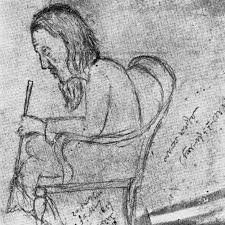Lalon, also known as Lalon Shah, Laoln Fakir, Mahatma Lalon, Lalon Sain. He was born 17th October ( According to Bangla Calender the day was Pahela Kartik) 1774 In the villavillage named Harishpur , Shoilkupa upazila, Jhenaidah district. He is the singer and composer of Baul songs or Lalon songs. According to tradition he was born into a Hindu (Kayastha) family. Someone says he born in a Muslim family. Before his birth, his father died and at the age of 06, he lost his mother. His parent’s names are also unknown. Lalon had no formal education.
During a pilgrimage to the temple Jaghanath (Murshidabad) with others of his native village, Lalon caught smallpox and in a critical condition he was abandoned by his companion on the bank of the River Kaligangha. Malam Shah and his wife Matigan, member of the weaver community, village of Cheuria, Kushtia district, took him to their home to convalesce. Lalon lost the sight of his one eye in smallpox. Malam Shah gave Lalon land to live and cultivate where he foundes a musical group and remained to compose and perform his songs. Lalon Inspired by Siraj Sain, a musician of Cheuria village to found a musical group. Lalon was the close friend of Kangal Harinath, one of the contemporary social reformars and was a disciple of Lalon.
The details of Lalon’s early life are made controversial mainly by urban-educated scholars representing communal tendencies among both Hindu and Muslim writers. Lalon also recorded very little information about himself. As a result, accounts of Lalon’s life are sites of speculative communal claims that has remained till today contradictory and unverifiable. It is clear, however, that he never revealed his social identity because of his consistent opposition against all forms of communal identity. He refused all his life to be trapped into the politics of identity of any kind. When people, particularly members of the urban the middle class who were already divided into Hindu and Muslim during colonial period, asked about his religion, Lalon mocked them. Many of his songs make mockery of those who degraded themselves to identity politics that divides a community, thereby creating conditions that generate communal conflict and violence. It is important that his intention is retained in any attempt to reconstruct a historiography of this great saint who even refused to be nationalist during the apex of the anti-colonial nationalist movements in the Indian subcontinent. With regard to identity the following song is fairly well known among his many other similar articulations:
They are curious to know what Lalon’s faith is, Says Lalon: The shape of religion eludes my vision.
Circumcision tells a Muslim from others,
But what is the mark of his woman?
The Brahman is known by his thread,
How do I tell who is a Brahmani?
Lalon’s philosophical expression, based on oral and textual traditions, was expressed in songs and musical compositions. The lyrics of his songs were explicitly meant to engage in the philosophical discourses of Bengal. He critically re-appropriated the various philosophical positions emanating from the legacies of Hindu, Jain, Buddhist and Islamic traditions, developing them into a coherent school of thought. Lalon’s songs have attracted widespread attention for their mystical approach to humanism as well as their melodious tunes. But even after 120 years of his death, we are yet to preserve all of his songs appropriately, though the government, corporate, NGOs and many individual researchers have been taking initiatives since the 1960s.
A common problem that arises during the documentation of any orally transmitted art form from the primary source is that nobody can claim his or her work to be absolutely authentic, since words change when it is transmitted from one singer to another. Lalon Geeti is no exception to the trend. According to his followers, Fakir Maniruddin Shah, a direct disciple of Lalon, used to note down the verses. According to the experts and true bearers of Lalon’s spirit, Lalon composed about 2,000 verses. However, many rural Bauls claim that Lalon composed over 10,000 songs. The problem is that years after Lalon’s death, many pseudo Bauls have labelled songs composed by other Baul gurus as Lalon’s.
Lalon was basically a humanist who completely dropped all distinctions of caste not to mention creed. He was also a poet and Lyricist, whose songs are sung but not just by his followers but even by non-Bauls. In 1963, a mausoleum and then a research center were built from the sight of his Akhra. Several thousand of Bauls come to the Akhara twice in a year. Doal-Purnima, in the Bengali month of Falgun (Feb-March) and Pahela Kartik ( Sep- October) on the occasion of his death anniversary. During these three day songs meals, Bauls pay rich tributes recommended to their spiritual leader.
Cheuria was under the Zamindari of the Tagores in Kushtia. Lalon had visited the Tagorefamily and performed there with his songs. The only portrait of Lalon was sketched by Zamindar Jyotirindranath Tagore ( Brother of Poet Rabindranath Tagore) in 1889 in his house boat on the river Padhma. Rabindranath Tagore never see Loalon, because he came to Kushtia after the death of Fakir Lalon Shah. Rabindranath Tagore was also inspired by his songs and published some of them in the monthly newspaper Prabasi of Kolkata. Lalon died at Cheuria at the age of 116 on 17th October 1890. Kangal Harinath published the death news of Lalon in the newspaper Gramerbartha Prakashika which run by him.

